Description
Shared Lane Markings (SLMs), or “sharrows,” are road markings used to indicate a shared lane environment for bicycles and automobiles. Among other benefits shared lane markings reinforce the legitimacy of bicycle traffic on the street, recommend proper bicyclist positioning, and may be configured to offer directional and wayfinding guidance. The shared lane marking is a pavement marking with a variety of uses to support a complete bikeway network; it is not a facility type and should not be considered a substitute for bike lanes, cycle tracks, or other separation treatments where these types of facilities are otherwise warranted or space permits. The MUTCD outlines guidance for shared lane markings in section 9C.07.
Click on the images below to view 3D concepts of shared lane markings. The configurations shown are based on Portland, OR, and San Francisco, CA, examples.
Treatment details can be accessed below under design guidance.
Shared Lane Marking Benefits
- Encourages bicyclists to position themselves safely in lanes too narrow for a motor vehicle and a bicycle to comfortably travel side by side within the same traffic lane. Read More+
- Alerts motor vehicle drivers to the potential presence of bicyclists.
- Alerts road users of the lateral position bicyclists are expected to occupy within the travel lane.
- Indicates a proper path for bicyclists through difficult or potentially hazardous situations, such as railroad tracks.
- Advertises the presence of bikeway routes to all users.
- Provides a wayfinding element along bike routes.
- Demonstrated to increase the distance between bicyclists and parked cars, keeping bicyclists out of the “door zone.” Read More+
“Along Dean Keeton Street, where bicyclists rode alongside on-street parked vehicles, the marginal increase in lateral position resulted in a significant decrease in the percentage of bicyclists who rode within the range of an opening car door.”
The Center for Transportation Research, The University of Texas at Austin. (2010). Effects of Shared Lane Markings on Bicyclist and Motorist Behavior along Multi-Lane Facilities.
“Overall, the presence of a marking increased the distance of cyclists to parked cars by 8 inches.”
“When passing vehicles were present, the markings caused an increase of 3 to 4 inches in the distance between cyclists and parked cars. In addition, the markings caused an increase of over 2 feet in the distance between cyclists and passing vehicles. The bike-and-chevron had a greater effect (by 3 inches) on the distance between cyclists and passing vehicles.”
San Francisco Department of Parking and Traffic. (2004). San Francisco’s Shared Lane Pavement Markings: Improving Bicycle Safety.
In the Cambridge, MA, study, the percentage of bicyclists who rode within 40 inches (i.e., near the door zone) of parked motor vehicles decreased.
Federal Highway Administration. (2010). Evaluation of Shared Lane Markings. FHWA-HRT-10-041.
- Encourages safe passing by motorists. Read More+
- Requires no additional street space.
- Reduces the incidence of sidewalk riding. Read More+
“Both the markings significantly reduced the number of sidewalk riders: the bike-and-chevron by 35% and the bike-in house by 25%.”
San Francisco Department of Parking and Traffic. (2004). San Francisco’s Shared Lane Pavement Markings: Improving Bicycle Safety.
“Before the arrow was placed, 39.3% of bicyclists rode in street, with traffic [versus on sidewalk.] After the arrow was placed, the proportion of bicyclists riding in street with traffic increased to 45.3%.”
Pein, W.E., Hunter, W.W., and Stewart, J.R. (1999). Evaluation of the Shared-Use Arrow. Florida Department of Transportation,Tallahassee, FL.
- Reduces the incidence of wrong-way bicycling. Read More+
Typical Applications
Shared lane markings should not be considered a substitute for bike lanes, cycle tracks, or other separation treatments where these types of facilities are otherwise warranted or space permits. Shared lane markings can be used as a standard element in the development of bicycle boulevards to identify streets as bikeways and to provide wayfinding along the route.
Desirable shared lane marking applications:
- To indicate a shared lane situation where the speed differential between bicyclist and motorist travel speeds is very low, such as:
|
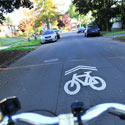 On bicycle boulevards or similar low volume, traffic calmed, shared streets with a designed speed of < 25 mph. On bicycle boulevards or similar low volume, traffic calmed, shared streets with a designed speed of < 25 mph. |
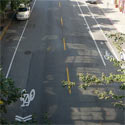 On downhill segments, preferably paired with an uphill bike lane. If space permits, consider a wide downhill bike lane. On downhill segments, preferably paired with an uphill bike lane. If space permits, consider a wide downhill bike lane. |
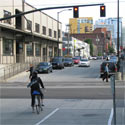 On streets where the traffic signals are timed for a bicycling travel speed of 12 to 15 miles per hour. On streets where the traffic signals are timed for a bicycling travel speed of 12 to 15 miles per hour. |
- As a reasonable alternative to a bike lane in limited circumstances:
|
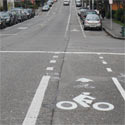 Where street width can only accommodate a bicycle lane in one direction. On hills, lanes should be provided in the uphill direction. Where street width can only accommodate a bicycle lane in one direction. On hills, lanes should be provided in the uphill direction. |
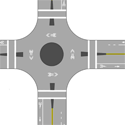 Within single or multi-lane roundabouts. Read More+ Within single or multi-lane roundabouts. Read More+
“The complexity of vehicle interactions within a roundabout leaves a cyclist vulnerable, and for this reason, bike lanes within the circulatory roadway should never be used.”
US Department of Transportation. (2000). Roundabouts: An Informational Guide. FHWA-RD-00-067.
|
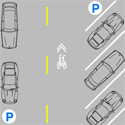 Along front-in angled parking, where a bike lane is undesirable. Along front-in angled parking, where a bike lane is undesirable. |
- To strengthen connections in a bikeway network:
|
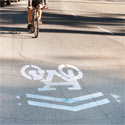 To fill a gap in an otherwise continuous bike path or bike lane, generally for a short distance. To fill a gap in an otherwise continuous bike path or bike lane, generally for a short distance. |
 To transition bicyclists across traffic lanes or from conventional bike lanes or cycle tracks to a shared lane environment. To transition bicyclists across traffic lanes or from conventional bike lanes or cycle tracks to a shared lane environment. |
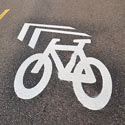 To direct bicyclists along circuitous routes. To direct bicyclists along circuitous routes. |
- To clarify bicyclist movement and positioning in challenging environments:
|
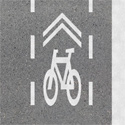 To designate movement and positioning of bicycles through intersections. To designate movement and positioning of bicycles through intersections. |
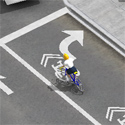 To designate movement and positioning of bicyclists through a combined bike lane/turn lane. To designate movement and positioning of bicyclists through a combined bike lane/turn lane. |
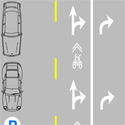 To assist bicyclists in taking the lane in the presence of a double turn lanes. Double turn lanes are undesirable for bicyclists. To assist bicyclists in taking the lane in the presence of a double turn lanes. Double turn lanes are undesirable for bicyclists. |
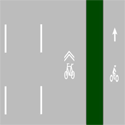 In the street alongside separated bikeway facilities such as cycle tracks, to permit continued use of the street by bicyclists who prefer to ride in the street. In the street alongside separated bikeway facilities such as cycle tracks, to permit continued use of the street by bicyclists who prefer to ride in the street. |
|
|
- Generally, not appropriate on streets that have a speed limit above 35 mph. Read More+
“The Shared Lane Marking should not be placed on roadways that have a speed limit above 35 mph.”
Federal Highway Administration. (2009). Manual on Uniform Traffic Control Devices. Section 9C.07 02.
The Toronto Cycling Study (2010) found that while 72.5% of all existing bicyclists are comfortable riding on major roads with bike lanes, only 54% reported feeling comfortable on major roads with sharrow markings.
City of Toronto/Ipsos Reid. (2010). City of Toronto Cycling Study: Tracking Report (1999 and 2009).
Design Guidance
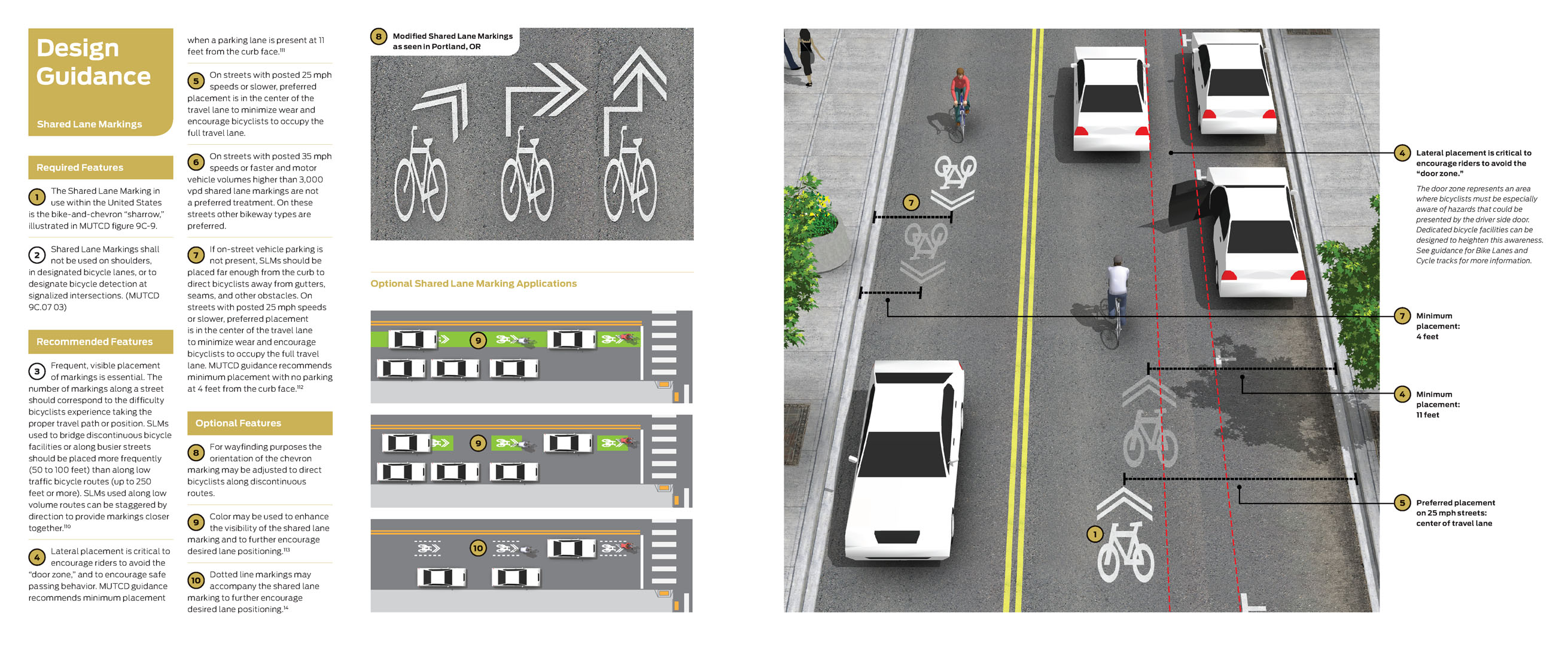
| Required Features |
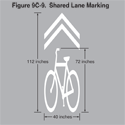 |
The Shared Lane Marking in use within the United States is the bike-and-chevron “sharrow,” illustrated in MUTCD figure 9C-9. |
 |
Shared Lane Markings shall not be used on shoulders, in designated bicycle lanes, or to designate bicycle detection at signalized intersections. (MUTCD 9C.07 03) |
| Recommended Features |
 |
Frequent, visible placement of markings is essential. The number of markings along a street should correspond to the difficulty bicyclists experience taking the proper travel path or position. SLMs used to bridge discontinuous bicycle facilities or along busier streets should be placed more frequently (50 to 100 feet) than along low traffic bicycle routes (up to 250 feet or more). SLMs used along low volume routes can be staggered by direction to provide markings closer together. Read More+
|
 |
Lateral placement is critical to encourage riders to avoid the “door zone” and to encourage safe passing behavior. MUTCD guidance recommends minimum placement when a parking lane is present at 11 feet from the curb face. Read More+
“When sharrows were placed in the center of the lane, a significant change occurred in average bicyclist lateral position, away from the curb and towards the center of the lane. This result was significant both when bicyclists were being passed by motor vehicles and when no passing was occurring, but was more pronounced in the latter instance.”
The Center for Transportation Research, The University of Texas at Austin. (2010). Effects of Shared Lane Markings on Bicyclist and Motorist Behavior along Multi-Lane Facilities.
Placement Guidelines for San Francisco
Laterally:
- 11’ minimum with parking
- 11.5’ general standard with parking
- May increase if higher cycling speeds are expected
SFMTA. (2008). Shared Lane Markings: When and Where to Use Them. Presented at Pro Walk/Pro Bike 2008.
If used in a shared lane with on-street parallel parking, Shared Lane Markings should be placed so that the centers of the markings are at least 11 feet from the face of the curb or from the edge of the pavement where there is no curb.
Federal Highway Administration. (2009). Manual on Uniform Traffic Control Devices.
|
 |
On streets with posted 25 mph speeds or slower, preferred placement is in the center of the travel lane to minimize wear and encourage bicyclists to occupy the full travel lane. |
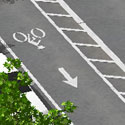 |
On streets with posted 35 mph speeds or faster and motor vehicle volumes higher than 3,000 vpd shared lane markings are not a preferred treatment. On these streets other bikeway types are preferred. |
 |
If on-street vehicle parking is not present, SLMs should be placed far enough from the curb to direct bicyclists away from gutters, seams, and other obstacles. On streets with posted 25 mph speeds or slower, preferred placement is in the center of the travel lane to minimize wear and encourage bicyclists to occupy the full travel lane. MUTCD guidance recommends minimum placement with no parking at 4 feet from the curb face. Read More+
SFMTA. (2008). Shared Lane Markings: When and Where to Use Them. Presented at Pro Walk/Pro Bike 2008.
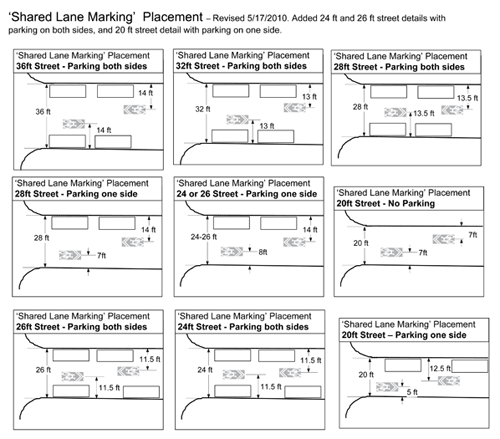 Portland Bureau of Transportation. (2011). Wayfinding Sharrow Guidelines. Portland Bureau of Transportation. (2011). Wayfinding Sharrow Guidelines.
If used on a street without on-street parking that has an outside travel lane that is less than 14 feet wide, the centers of the Shared Lane Markings should be at least 4 feet from the face of the curb or from the edge of the pavement where there is no curb.
Federal Highway Administration. (2009). Manual on Uniform Traffic Control Devices.
|
| Optional Features |
 |
For wayfinding purposes the orientation of the chevron marking may be adjusted to direct bicyclists along discontinuous routes. |
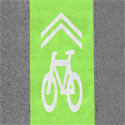 |
Color may be used to enhance the visibility of the shared lane marking and to further encourage desired lane positioning. Read More+
Salt Lake City, UT, and Long Beach, CA, have used a carpet of green coloring to create a lane-within-a-lane to indicate the priority area and preferred riding placement for bicyclists.
“The green lane facility has appeared to result in an approximate doubling of usage over the first 12 months of existence.”
“Bicyclists familiar with more traditional sharrows have noted that the additional emphasis resulting from the green pavement paint appears to be creating an heightened awareness by the motorists in the lane.”
City of Long Beach. (2010). Final Report: Second Street Sharrows and Green Lane in the City of Long Beach, California. RTE 9-113E.
In an evaluation of a lane-within-a-lane treatment in Sald Lake City, researches found that “Eleven months after implementation, the fraction of in‐street cyclists riding in the preferred zone, at least 4 ft from the curb, had risen from 17% to 92%.”
Furth, P., Dulaski, D. M., Bergenthal, D., Brown, S. (2011). More Than Sharrows: Lane-Within-A-Lane Bicycle Priority Treatments in Three U.S. Cities. Presented at the 2011 Annual Meeting of the Transportation Research Board.
|
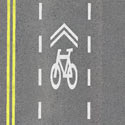 |
Dotted line markings may accompany the shared lane marking to further encourage desired lane positioning. Read More+
Configurations in Brookline, MA, have used dotted lines to create a lane-within-a-lane to indicate the priority area and preferred riding placement for bicyclists.
“The lane‐within‐a‐lane treatment appears to be effective in bringing about a shift in bicyclist position away from right‐side hazards.”
Furth, P., Dulaski, D. M., Bergenthal, D., Brown, S. (2011). More Than Sharrows: Lane-Within-A-Lane Bicycle Priority Treatments in Three U.S. Cities. Presented at the 2011 Annual Meeting of the Transportation Research Board.
|
Maintenance
- Frequent, visible placement of markings is essential.
- Lateral placement is critical to encourage riders to avoid the “door zone.”
- The shared lane marking may be placed in the center of the lane between wheel treads to minimize wear.
Treatment Adoption and Professional Consensus
- Used by at least 76 jurisdictions in 26 States as of 2009, including most NACTO member cities.